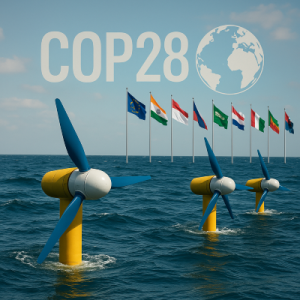COP28 Highlights: What’s New for Ocean Energy?
As the 28th United Nations Climate Change Conference (COP28) came to a close, the global focus shifted towards practical climate solutions. While solar and wind energy continue to capture attention, ocean energy has quietly emerged as a significant player, making waves both literally and politically. So, what transformations occurred at COP28 regarding ocean energy, and why is it important?
In this article, we will explore the advancements, commitments, and pivotal moments for marine renewables at COP28. Whether you are an energy advocate, policymaker, or sustainability supporter, this update brings a refreshing wave of optimism.

A Shift in Global Focus
To start, COP28 represented a notable change in the discourse surrounding ocean energy. Unlike earlier summits where marine renewables barely made an appearance in mainstream discussions, this year ocean energy finally secured a place at the climate action table. This shift was largely driven by increasing pressure from island nations and coastal states who are experiencing the harsh impacts of climate change—and who recognize the untapped potential in their adjacent waters.
Furthermore, the inclusion of ocean energy in various plenary sessions and side events highlighted its essential role in reaching net-zero goals. For the first time, blue energy was no longer an afterthought—it took center stage.
Significant Announcements that Made Waves
-
Global Blue Energy Agreement Unveiled
One of the most significant announcements from COP28 was the introduction of the Global Blue Energy Agreement. Signed by 30 coastal and island nations, this pact aims to accelerate the development of wave, tidal, and ocean thermal energy conversion (OTEC) technologies by 2035.
Additionally, the agreement features a funding mechanism supported by the World Bank and the Asian Development Bank, which will unlock up to $5 billion in blended finance for marine energy infrastructure.
🌊 “Ocean energy is not a luxury; it’s a necessity,” stated the Pacific Climate Coalition during the signing ceremony.
-
UN Framework for Sustainable Ocean Energy Development
Another key development was the launch of a UN-endorsed framework for sustainable ocean energy advancement. This framework establishes environmental and social governance (ESG) criteria specifically designed for offshore and near-shore renewable energy initiatives.
Importantly, the framework was crafted in collaboration with Indigenous coastal communities, marine ecologists, and industry experts—ensuring that ecological protections and community advantages are aligned.
Technological Innovations Driving Progress
While policy frameworks are indispensable, technological advancements serve as the primary catalyst for transformative change. At COP28, numerous technological innovations and pilot initiatives were presented, underscoring the swiftly advancing landscape of marine renewable energy.
-
Floating Tidal Arrays
Enterprises such as Orbital Marine Power unveiled prototypes of floating tidal turbine platforms that can be towed and installed without necessitating intricate seabed anchoring. These systems are anticipated to facilitate expedited installation and reduced expenditures, particularly in remote locales.
-
Hybrid Maritime Microgrid System
Startups originating from Norway, Japan, and Canada introduced marine microgrids that synergistically combine wave, tidal, and solar energy inputs. These systems hold significant promise for island communities, providing a pathway towards complete energy autonomy.
-
Digital Twins for Ocean Turbines
The incorporation of artificial intelligence and digital twin technology for the predictive maintenance of marine turbines also garnered considerable attention. By simulating operational performance in real-time, operators can substantially extend the lifespan of equipment and markedly decrease periods of inactivity.
With these advancements, the outlook for ocean energy appears exceptionally optimistic.
Financing the Blue Revolution
It is evident that one of the most significant impediments to the advancement of ocean energy has been the issue of financing. However, COP28 signaled a positive shift in this regard.
💰 Private Sector Participation
Prominent energy corporations such as Ørsted and Shell announced exploratory investments in wave and tidal startups, reflecting an increasing level of confidence in the sector. Concurrently, BlackRock committed to incorporating marine renewables into its green transition fund portfolio, commencing in 2025.
🌍 Sovereign Wealth Initiatives
Countries such as the UAE and Norway unveiled initiatives backed by sovereign wealth to finance ocean energy pilot projects in the Global South. This financial support is essential for facilitating the transition away from fossil fuels in energy-deficient coastal regions.
In light of these announcements, the financial prospects for marine renewables are more favorable than ever.
Environmental Concerns Remain Present
Nevertheless, COP28 was not without challenges for advocates of ocean energy. Environmental non-governmental organizations expressed valid concerns regarding the potential repercussions of extensive deployments on marine biodiversity and ecosystems.
To mitigate these concerns, the recently established UN framework mandates:
- Marine Protected Area (MPA) compatibility assessments.
- Real-time monitoring utilizing acoustic and visual sensors.
- Mandatory consultations with local fishing communities prior to project approval.
While these guidelines do not entirely eliminate all risks, they do establish a higher standard for accountability and ecological stewardship.
Regional Leaders in Ocean Energy
Another noteworthy outcome from COP28 was the emergence of regional leaders within the ocean energy sector.
🌐 Europe
The European Union reaffirmed its Ocean Energy Strategy with a revised objective: 100GW of installed marine capacity by 2050. Furthermore, they committed to harmonizing permitting regulations among member states to facilitate deployment.
🌏 Asia-Pacific
Japan, South Korea, and Indonesia pledged to foster regional collaboration on ocean energy research and development, aspiring to create a transnational blue energy grid by 2040.
🌍 Africa
Senegal and South Africa, with support from the African Development Bank, announced initiatives to investigate wave energy solutions for rural electrification.
This upsurge in regional engagement ensures that the development of ocean energy is genuinely a global undertaking.
What This Signifies for the Maritime Sector
For maritime enterprises, port administrations, and offshore operators, the advancements presented at COP28 unveil numerous prospects:
- Electrification of ports utilizing marine energy resources.
- Auxiliary power systems with low emissions for vessels operating at sea.
- The incorporation of wave energy conversion technologies on offshore installations.
Evidently, marine energy transcends mere electricity generation—it encompasses the facilitation of innovative blue economy solutions throughout the maritime value chain.
Looking Forward: Will the Momentum Persist?
As we anticipate COP29 and subsequent gatherings, the pertinent inquiry is not whether ocean energy possesses potential—but rather whether it can scale expeditiously to effect significant change. Optimistically, the initiatives undertaken at COP28 indicate that the global community is finally poised to harness the latent energy within our oceans.
Nonetheless, the realization of success will hinge on the efficacy with which governmental entities, private investors, researchers, and local communities can engage in collaborative efforts. The ocean has historically served to connect continents—now it may also serve to unite us through sustainable energy solutions.
Final Reflections
In conclusion, COP28 represented a pivotal juncture for ocean energy. With the introduction of novel funding mechanisms, policy frameworks, and technological innovations, marine renewables have transitioned from peripheral concerns to central components of mainstream energy discourse. Although obstacles persist, the current trajectory is shifting—and the outlook appears promising.
Therefore, if one has not been actively monitoring the ocean energy sector, now is an opportune moment to commence. Because henceforth, the ocean may very well emerge as our most formidable ally in the battle against climate change.


